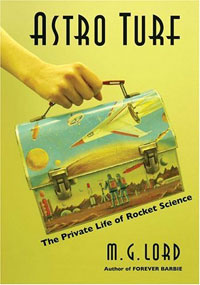Review: Astro Turfby Jeff Foust
|
| “In may ways,” she writes, “the midcentury so-called rocket scientist can be viewed as an archetype for masculinity, just as, for example, the Barbie doll can be seen as an icon of femininity. Both are abstract ideals, which no human person can ever fully embody.” |
Lord uses that experience as a springboard for a broader look at how JPL in particular has changed over the years. Rather than a continuous history, she offers a series of vignettes of experiences over the years. She studies Frank Malina, who co-founded the lab back in the 1930s as a place to do rocket experimentation outside of the Caltech campus. While Malina helped developed rocket engines to assist heavy planes to take off during World War 2, his ties—real or perceived—to communist organizations effectively exiled him to France in the 1950s, where he took up a second career as an artist.
That intolerance is contrasted with the gradual acceptance of women at the lab as equals, rather than as secretaries or the human “computers” that ran the then state-of-the-art calculating devices of the day. Lord credits those changes to the efforts of people like Marcia Neugebauer, the first female project scientist on a JPL mission, and Donna Shirley, who rose through the ranks to eventually manage the lab’s Mars exploration efforts. The work they did, from reforming JPL’s maternity leave policy to creating a child-care center at the lab, and the example they set opened the door to other women. Even if today only about one in five technical employees at JPL are women, it’s a far cry from four decades ago, when the ratio was closer to one in fifty.
The growing acceptance of women at JPL, and aerospace in general, is a change for the better for both men and women, she argues. “In may ways,” she writes, “the midcentury so-called rocket scientist can be viewed as an archetype for masculinity, just as, for example, the Barbie doll can be seen as an icon of femininity. Both are abstract ideals, which no human person can ever fully embody.” (The Barbie reference is not a throwaway line: Lord’s previous book was Forever Barbie, a history of the doll and how it shaped American culture.) While Astro Turf is not an exhaustive examination of how JPL or NASA has become more diverse over the last few decades, it does offer some insight as to how and why “rocket science” is no longer the exclusive domain of men.
